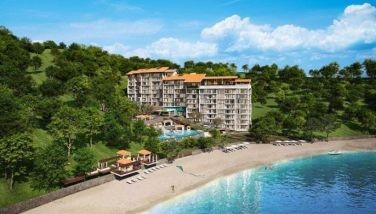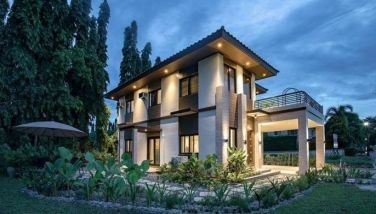Connecting Filipinos thru modular steel bridges
MANILA, Philippines - Before 2009, barangays Miputak, Sta. Isabel, Dalas, Central and Sta. Filomena in Sta. Isabel Dipolog City were veritable farmers’ villages. But their residents had a hard time going to the city proper to sell their goods. They had to travel hours through rough roads. Not to mention risked their lives every time they were to cross a bamboo bridge on board the habal-habal.
When it rained, there was no way they could cross the river because the bamboo bridge would always be washed away by the strong currents. Farmer families usually waited for days on end just to sell their goods. They were always on the breadline.
But that changed in 2009 when the bamboo bridge was taken down to give way to the construction of the Miputak-Sta. Isabel steel bridge under the President’s Bridge Program (PBP).
Since then, the lives of the hundreds of families in the farmers’ village have never been the same again.
Dipolog City Mayor Evelyn Uy was all praises for the steel bridge constructed by French firm Matiere under the Mega Bridges for Urban and Rural Development of the Department of Public Works and Highways.
Aside from being aesthetically pleasing, the steel bridge took little time to construct since they are modular and could be transported easily.
Most of all, it is cost efficient as its construction has no cost overrun unlike other bridge suppliers. The French government-assisted Mega Bridges through Eiffel Matiere require a measly 11.89 percent government counterpart, the least among all existing suppliers. Other suppliers require equity of at least 20 to 40 percent of project cost. With the very minimal government counterpart, the bridges are built even before target completion date because Matiere does not have to wait for budget releases that are perennially delayed.
Unlike other suppliers and contractors who always have delays, Matiere has always been built ahead of schedule so there is no cost overrun. This has been certified by the Commission on Audit in its recent report that the PBP through Matiere (formerly undertaken by Mabey & Johnson of United Kingdom) has not incurred any cost overrun in the 16 years of its implementation in the Philippines.
Because of the absence of cost overrun, the PBP incurred cost underrun or savings amounting to P2.2 billion in 2007 enabling the government to build 2 flyovers (San Fernando, Pampanga and Malolos Bulacan) and 150 more bridges without additional cost to the Philippine government.
Former Senator Aquilino Pimentel was also praises for the French bridges saying that unlike other contractors and suppliers, the Matiere bridges deliver the complete package including the massive steel superstructure, anti-skid decks, pedestrian walkways, the substructure, and other required assemblies.
Matiere bridges are also well-built as they are designed to last long – up to 100 years and 2 million cycles with very minimal maintenance. One cycle is defined as the movement of one vehicle at the maximum weight allowed crossing the length of the bridge at the legal speed. It can accommodate a load of up to 80 tons unlike other bridges. The Matiere steel bridges are blasted with three different kinds of paint to ensure against rust and other damage including corrosion. It also has an anti-skid coating.
It can be used for permanent structures or for short term applications. It can be moved to another location even after a long permanent application.
In contrast, according to the COA Report, the other suppliers like Balfour Cleveland had already incurred cost overruns by almost 100 percent while Wagner Biro of the Austrian government-assisted project under the Special Bridges Project cost the government 62 percent more or an additional P117.54 million due to construction delays.
While the other suppliers claim their bridges cost less, an analysis of the costing would show that they cost far more than Matiere’s. A comparative tabulation of bridge project suppliers shows that with respect to Balfour Cleveland, while its original cost of the project was pegged at around P2.4 billion, it incurred cost overruns, because of delays in construction, amounting to almost P3 billion or more than a 100 percent of the original project cost. In the end the government paid more than P10 billion (after repayment, meaning including interest and fees) for a project originally costing P2.4 billion.
Matiere’s Unibridge costs P1.085M per lineal meter while Balfour Cleveland costs P1.021M per lineal meter. While Matiere costs five percent more, it merely requires a government counterpart fund of only 11.89 percent while Balfour requires as much as 154.52 percent from the Philippine government or more than the cost of the project because of cost overruns due to delays. Moreover, because Matiere’s delivery of the bridges way ahead of schedule, its beneficiaries get to use the bridge much early on thereby hastening economic growth in the areas where the bridges are built.
In addition, the other bridge projects claim they cost much less but it is because their per lineal meter cost include only the bridging materials and not the substructure and decks which they charge to the Philippine government. Matiere’s price include all substructure and decks.
Also other bridge programs use the old reinforced concrete with is subject to cracking and hard to check as the concrete conceals substandard materials or poor workmanships.
The COA said the DPWH should collect unliquidated damages from defaulting suppliers and contractors and thereafter blacklist them.
Another Matiere bridge is the Puerto-Sayre Flyover in Cagayan de Oro City which has become a boon to Bukidnon farmers who now spend only 1.5 hours in bringing their agricultural commodities to the regional capital of Northern Mindanao.
Previously, they had to spend four hours in traveling from Malaybalay and other towns to sell their goods in Cagayan de Oro, and the long travel time had been a bane to the farmers since quality of their vegetables suffers.
This flyover, inaugurated by President Benigno Simeon Aquino III in September 21, 2011, has also helped in bringing in food, water, medicines, clothes and other essential goods to be distributed among the 45,000 families who were victimized by the deadly fury of Typhoon Sendong in the dead of the night of December 17.
President Aquino was praised for the timely construction of the Puerto Sayre Flyover under the Mega Bridges project.
Puerto Sayre Flyover is one of three flyovers that had been approved for the Mega Bridges for Urban and Rural Development Project.
Under this program, 10 girder-type flyovers were to be built, along with 72 unibridges, from March 2009 to 2012.
The project cost was placed at P9,452,420,008, with the money coming from the French government’s export credit loan and the Philippine government.
Apart from the Puerto Sayre flyover, government is working on the Lazatin Flyover in San Fernando City in Pampanga and the Bacolod-Lacson Flyover in Bacolod City.
The Jalandoni Flyover in Iloilo City was actually the first one completed under the Aquino administration since it was finished on July 9, just 8 days after the President took office.
These flyover projects are unique since they utilize the permanent prefabricated modular steel technology from France developed by Eiffel & Matiere.
With the successful completion of the Puerto Sayre Flyover, the DPWH is now working on the designs and pre-engineering works for 52 out of 72 spans of medium-sized two-lane unibridges.
Eiffel & Matiere is also handling six out of 10 flyover candidate sites in the following areas: Tarlac City; Binalonan, Pangasinan; Panabo City, Davao del Norte; Naga City; Marilao, Bulacan, and; Araneta-Magsaysay in Bacolod City.
Indeed the PBP is a parallel intervention to fast track the provision of critical infrastructure development support aimed to address the country’s ballooning bridge requirement of about 15,000 or about 200,000 lineal meters of local and national bridges as reflected in the Medium-Term Philippine Development Plan.
Annually, the Philippines have to deal with 22 to 27 typhoons or natural calamities destroying or weakening some 10,000 lineal meters of existing bridges.
Even if foreign donor countries can supply an average of 20,000 lineal meters of bridges, there is still some 170,000 lineal meters of bridging required to be urgently constructed based on the 1994 NEDA approved master plan of bridges.
The PBP linked the remotest and poorest communities with the nation’s road network and highly urbanized centers creating an opportunity of spreading the fruits of economic progress to the greatest number of the populace.
In 1994, the UK government was trying to open up bilateral cooperation between the Philippines and the UK, A UK ATP team came and assessed if the UK government can assist the Philippines through the provision of steel bridges in the rural areas to promote development. The bilateral cooperation arrangement was signed by no less than Lady Baroness Chalker. Based on the ATP study, a Task Force on the President’s Bridge Program was created by Pres. Ramos chaired by then Executive Secretary Guingona composed of 6 major line departments.
Approved PBP Projects
Like all Foreign Assisted Projects, all PBP projects pass through the NEDA-ICC process where the feasibilities and concessionality of financing of projects are assessed. The NEDA ICC is composed of 12 major line departments of the Government with three levels each of review and approval: Technical Committee; Cabinet Committee; and the NEDA Board.
Upon NEDA Board approval, the DOF negotiates the project’s financing which is approved by the Monetary Board. The contract is reviewed by the DOJ prior to contract signing. After the Philippine Government processes, the contract is reviewed and declared effective by the UK Government.
PBP projects are implemented by DPWH and funds are released directly to the agency through the Department of Budget and Management. The Department of Finance monitors and reports to the Monetary Board the utilization of the foreign and local component of the project. DPWH provides regular accomplishment reports to the President and the NEDA. The UK bridge supplier Mabey & Johnson submits monthly reports to the UK ECGD.

- Latest






























